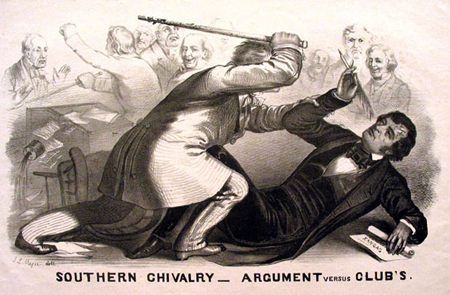Attempting to draw the line
between those who engage in passionate political discourse and extremist
incitement is one fraught with risk for American terrorism analysts. After
partisan talk radio and the blogosphere went ballistic over some awkward wording
in an overall excellent prescient report on right-wing extremism, DHS apparently
disconnected the printers in their Homeland Environment Threat Analysis
Division. There hasn’t been much output from them since. Pundit Michelle Malkin, nominated for a
Pulitzer in bigotry for her magnum opus
book “In Defense of
Internment: The Case for ‘Racial Profiling’ in World War II and the War on
Terror” was highly critical. She called the report an embarrassingly “shoddy”
piece of “propaganda.”
Following
complaints about their report on Islamic radicalism the NYPD quietly issued a
clarification two years after its release and right before the city’s most
recent plot, that rightly said: “NYPD's focus on al-Qaeda inspired terrorism
should not be mistaken for any implicit or explicit justification for racial,
religious or ethnic profiling.” The FBI and certain Muslim groups are trying to
resolve disputes about the extent of FBI monitoring of mosques. And after a
January 2009 government report on eco-extremism that movement retaliated by
exporting valuable arsons and explosive producing crimes to pipelines in Canada
and drug companies and banks in Mexico.
Monitoring for potentially
dangerous folks based on wide ranging political affiliations, as well as
geographic origins, or religious belief for that matter can ensnare innocent
folks and alienate potential allies when it is overbroad.
Intense political jousts like
the raucous one over healthcare mostly involve peaceful mainstream folks, but
the presence of real extremists should not be ignored either. Several key,
though non conclusive, indicators of extremist philosophy to look for include
an embrace of violence, opting out of preexisting communal social and political
bonds, a distinct historical narrative, and a rigid embrace of falsehoods and
conspiracy theories.
Danger Lurks South of The
Border
While overbroad and
inaccurate analysis of the extremist risk is often faulty and bigoted, it can
sometimes be equally humorous. Though some broadly look to annoyed conservatives,
and others to animal lovers, pro-life advocates or those who fast during
Ramadan in their wide-net search for dangerous extremists, I narrow my focus on
the state of South Carolina. For centuries these aloof rebel folks can’t seem
to get along with anybody—even each other.
While much has been made of
South Carolina Congressman Joe Wilson’s recent “you lie” outburst toward President Obama, the guffaw
barely moves the needle on the national historical political conflict scale. At
times political differences and personal enmity can grow so intense that it is
the politicians themselves, rather than disenfranchised fringe dwellers who
resort to incivility, or even violence.

While the Wilson event is
barely a “dishonorable mention” on the Palmetto State’s longstanding varsity
roster for no holds barred political conflict and division, it does offer a
starting point for analysis—at least from a humor standpoint. First off, for
the record I am not even one of those people who are a bit wary of folks who come
from places with a crescent moon on their flag. Most people outside of South
Carolina don’t even know what the flag looks like because the Confederate
battle flag still flies prominently over the state capitol grounds-prompting
some economic boycotts.

Let’s look at the numbers:
The Southern Poverty Law Center counts 45 hate groups in the state—the highest
per capita of any state in the union, if it still in fact is in the Union.
Mississippi and Louisiana have a combined total of only 44 hate groups. There
are so many hate groups in the state that a store—The Redneck Shop--had to open
to supply these folks with all their bumper stickers and apparel. These sales
hopefully will make up for losses due to the socialist boycotts over the rebel
flag. And don't forget that Al Qaeda aider Jose Padilla called a South Carolina military brig home, albeit against his will, for five years.
The state reported a whopping
156 hate crimes in 2007 compared to 0 in Mississippi, 6 in Alabama , and 14 in
Georgia. Of course 55 agencies in South Carolina actually submitted completed
crime reports, while only 8 departments in all those other states combined bothered
to, but that kind of accuracy ruins my headline point about the state’s
dangers.
Next let’s look at the
turbulent history and angry political orientation of the state. When they
couldn’t get along the rest of Carolina, they split in 1719. Then in March 1776 they skirmished with
the British and became the first state to declare independence. The state was
also where a disgraced Aaron Burr sought refuge in 1804 after killing Alexander
Hamilton in a New Jersey duel.
Author Robert Maxwell Brown
explained, “Among all Southern states before the Civil War South Carolina was
the leader in sectional extremism.” South Carolina born Andrew
Jackson couldn’t get along with his own Vice President, another South
Carolinian named John Calhoun. Shortly thereafter, the state spawned the
Nullification Doctrine—the contention that if states find a federal law to be
unconstitutional, they can just ignore it—kind of like Congressman Wilson’s
stance on manners. “Turncoat”
Jackson, who since claimed to be a Tennessean, obtained Congressional
authorization to use military force against his birth state, if necessary,
forcing the South Carolina legislature to make a temporary reversal on
Nullification. Calhoun was even
falsely suspected by conspiracists, and by the President, of being behind a
failed assassination attempt on Jackson by an insane house painter. South
Carolina later took Nullification to the extreme when it became the first state
to secede in 1860 and the place where the first shots of the Civil War were fired
in 1861.
By historic standards
Congressman Wilson is downright genteel. In 1857 South Carolina Congressman
Preston Brooks severely beat Massachusetts Senator Charles Sumner over the head
with a thick gold tipped cane in the Senate chambers after the Massachusetts
senator insulted South Carolina’s senator (and Brooks’ uncle) over slavery.
While Wilson got his reelection coffers filled as a result of his outburst,
South Carolinians sent Brooks dozens of canes to replace the one he split over
Sumner’s head. Despite the foregoing I am not quite ready to put checkpoints up
on interstate 95 at the state lines.
The point of this tongue in
cheek exercise is that a dose of judgment is needed when sifting for dangerous extremists
out of a larger peaceful group. Extremism is often a contorted carnival mirror
reflection of actual controversies in the mainstream. The key for analysts of right-wing and other extremism is to
be able to differentiate dissenters from destroyers. Extremists have opted
out—they seek to destroy and exploit the processes, diversity and institutions
of our pluralistic democracy beyond winning on an issue or particular set of
issues. The risk of wildfires doesn’t mean we should ban blowing grass from the
landscape. However, it is also important to be aware that in troubled times
when atmospherics change, sparks, even unintentional ones, pose a greater risk
as the dry grass of extremism spreads.
